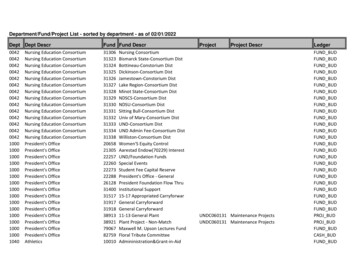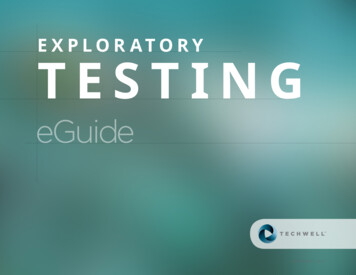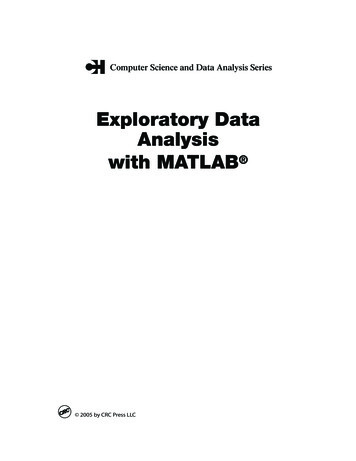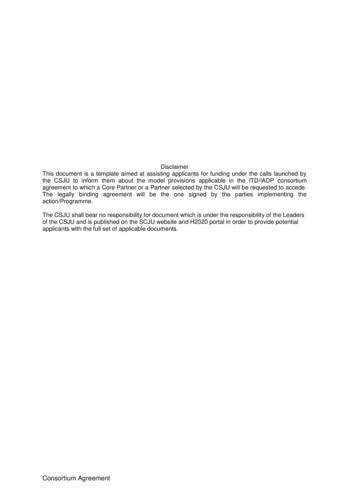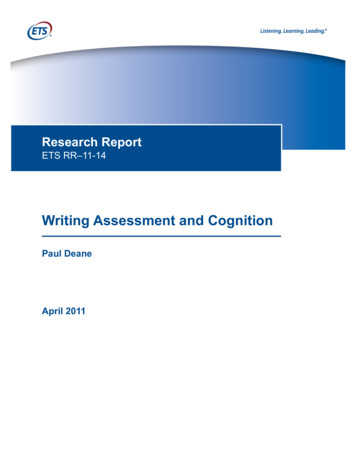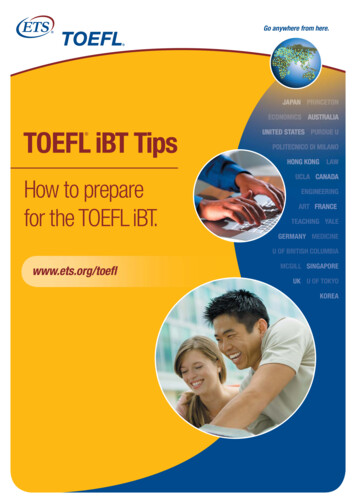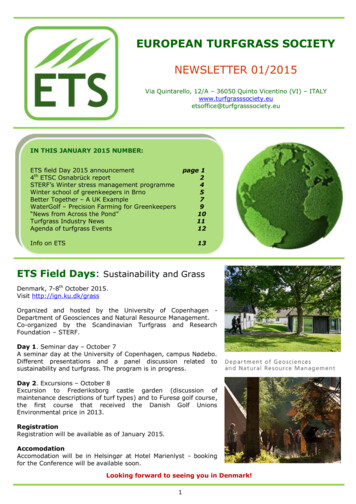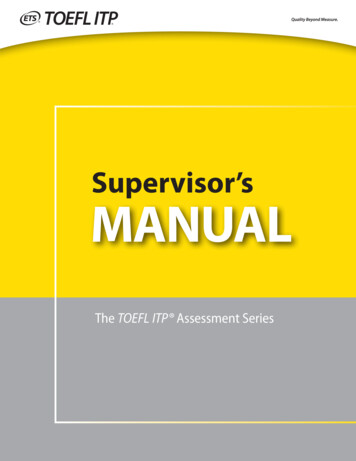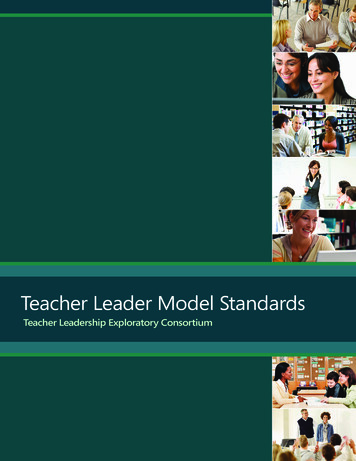
Transcription
Teacher Leader Model StandardsTeacher Leadership Exploratory Consortium
Table of ContentsPreface . . . . . . . . . . . . . . . . . . . . . . . . . . . . . . . . . . . . . . . . . . . . . . . 3Acknowledgements . . . . . . . . . . . . . . . . . . . . . . . . . . . . . . . . . . . . . . . . . 6Introduction . . . . . . . . . . . . . . . . . . . . . . . . . . . . . . . . . . . . . . . . . . . . . 8Vision Document . . . . . . . . . . . . . . . . . . . . . . . . . . . . . . . . . . . . . . . . . . 10Teacher Leader Model Standards . . . . . . . . . . . . . . . . . . . . . . . . . . . . . . . . . 14Policy Document . . . . . . . . . . . . . . . . . . . . . . . . . . . . . . . . . . . . . . . . . . 21Glossary of Terms . . . . . . . . . . . . . . . . . . . . . . . . . . . . . . . . . . . . . . . . . 34References . . . . . . . . . . . . . . . . . . . . . . . . . . . . . . . . . . . . . . . . . . . . . 38Appendix . . . . . . . . . . . . . . . . . . . . . . . . . . . . . . . . . . . . . . . . . . . . . . 41
PrefaceIn May 2008, a group of concerned educators convened to examine the current research andthinking about the critical leadership roles that teachers play in contributing to student andschool success. These educators believe that teacher leadership is a potentially powerfulstrategy to promote effective, collaborative teaching practices in schools that lead to increasedstudent achievement, improved decision making at the school and district level, and create adynamic teaching profession for the 21st century.This initial group subsequently expanded its membership and mission to form theTeacher Leadership Exploratory Consortium, which represents a broad array of educationorganizations, state education agencies, teacher leaders, principals, superintendents, andinstitutions of higher education (a list of members follows this preface). This expanded groupembarked on the development of model standards for teacher leadership in August 2008 andhas now completed its work.The purpose of these standards—like all model standards—is to stimulatedialogue among stakeholders of the teaching profession about whatconstitutes the knowledge, skills, and competencies that teachers need toassume leadership roles in their schools, districts, and the profession.Model standards are often used in the development of curriculum, professionaldevelopment, and standards for such entities as school districts, states, professional organizations,and institutions of higher education. These standards are designed to encourage professionaldiscussion about what constitutes the full range of competencies that teacher leaders possessand how this form of leadership can be distinguished from, but work in tandem with, formaladministrative leadership roles to support good teaching and promote student learning.3
Preface cont’dIn order to draft these standards, the Consortium members reviewed research, examinedexisting state-level teacher leadership programs, met with researchers, and learned from teacherleaders, who had experienced the challenges and successes of serving in those roles. Theyalso examined how teacher expertise is a critical component of effective and credible teacherleadership. The group examined critical concepts related to teacher leadership such as adultlearning models, negotiation, collaboration paradigms, learning communities, facilitation skills,advocacy, and professional development/learning.They explored different models of teacher leadership and delineatedthe variety of formal and informal roles exercised by teacher leaders.They also examined the role of teaching expertise and effectiveness inregard to teacher leadership.In the current policy context, the concept of teacher leadership is undergoing intensescrutiny. In the past year alone, at least eight books on the subject have been published, inaddition to countless articles. An increasing number of institutions of higher education areoffering degree programs in teacher leadership. A growing number of states are including teacherleader stages within their professional continuum structures.These developments prompted in-depth discussions by Consortium members aboutthe nature of both formal and informal teacher leadership and the multiple pathways intoteacher leadership roles. There was recognition that some distinguished teacher leaders havedeveloped their leadership knowledge through professional experience and mentoring. Otherteacher leaders have pursued more formal training or recognition such as advanced degrees,additional course credits, and/or certification/licensing through national organizations such asthe National Board for Professional Teaching Standards or state credentialing agencies as entryinto teacher leadership roles. Some individuals choose to lead informally from the classroom orto assume leadership roles in their local or state teacher professional associations or in other4
professional contexts. Others have been selected by their principals to assume more formalizedleadership roles in their schools and districts and may be encouraged to assume these leadershipopportunities as a pathway to administration.Members asked hard questions. Does one have to be a great teacher in order to be ateacher leader? Is every teacher a teacher leader? Can every teacher be a teacher leader? Whatkinds of knowledge and skills must a teacher learn or develop in order to serve effectively asa teacher leader? How should teacher leaders be selected? How do we support teachers inleadership roles? Some of these questions were beyond the purview of the Consortium to answer.However, the discussions, arguments, and compromises that resulted informed the standards andthe policy recommendations that emerged from this work.The initial draft Standards were released for public comment in March of 2010.Commentary received was examined carefully, and adjustments to the Standards were madeas a result of that input.The Standards follow a format similar to that of the Interstate School Leaders LicensureConsortium (ISLLC) State Standards for School Leaders—that is, a series of broadly statedexpectations or “domains” that define critical dimensions of teacher leadership. Under eachdomain, there are “functions” that more specifically define the range of actions or expectations forteacher leaders related to that domain. The Teacher Leadership Standards have been “mapped”or cross-referenced to the ISLLC standards in this booklet. In addition, the Teacher LeadershipStandards will also be “mapped” to the revised Interstate Teacher Assessment and StandardsConsortium (InTASC) standards, originally released in 1992 to reflect model standards forlicensing new teachers. The InTASC standards are currently being updated to reflect professionalpractice standards for all the developmental stages of a teacher’s career.The Consortium members hope that you find these Standards thought-provoking,inspiring, and, above all, useful as you begin your own explorations of the many dimensionsof teacher leadership.5
AcknowledgementsThe Consortium wishes to recognize the contributions of the following to the envisioning anddevelopment of the Standards:Linda Darling-Hammond, Margaret Gaston, Jennifer York-Barr for serving as sounding boardsin the early days of this work and for asking hard questions and providing encouragementScientists Jeremy Burrus and Richard Roberts for teaching us about adult learning, negotiation,and collaborationWalt MacDonald and Linda Tyler of the Educational Testing Service for their willingness todevote resources to this projectMark Smylie for his research and for coining the phrase, “anoint and appoint” in referencing theway in which some teacher leaders are selected; this gave us much to considerThe education community for responding to the draft standards during the public commentperiod; you shaped the final version of these standards and your vision, criticism, and supportis deeply appreciatedThe Center for Teaching Quality for its high-quality production of the pilot survey instrumentand resultsJo Anderson and Michelle Bissonnette of the United States Department of Education for theirunwavering encouragement and support throughout the processFinally, and most especially, Gene Wilhoit, Executive Director of the Council of Chief StateSchool Officers, for his constant encouragement, for asking hard questions, for inspiring thework, and for his unwavering belief that teacher leaders deserve to be empowered and trained,and are a vital part of school communities. Without his passion and support, these standardswould not exist.6
Teacher Leadership Exploratory ConsortiumAffiliationNameAmerican Federation of TeachersAmerican Institutes for ResearchArkansas Department of EducationBayonne Public SchoolsBethel CollegeBrandeis UniversityCalifornia Commission on Teacher CredentialingCenter for Teaching QualityRosalind LaRocqueMolly LasagnaBeverly WilliamsDeborah ShineAllen JantzVivian TroenCheryl HickeyBarnett BerryAnn ByrdLois Adams-RodgersMary CanoleKathleen PaliokasDana Boyd*Kristen NavarroKimberly AshBarbara ThompsonKatherine Bassett*Gregory VafisLeslie ButzJack DaleKelly HensonTom HigginsKatherine BolesPamela ColemanRobert BrownPhillip RogersJoellen KillionSteven GilhuleyMarguerite Izzo*Ada Beth CutlerCarol RileyLinda DavinSegun EubanksEileen Aviss-SpeddingChristopher CampisanoVictoria DuffMarilyn TroyerKeith MenkAnne CatenaDavid SevierHeidi RamirezCharlotte DanielsonMeredith CurleyPeggy Stewart* **Terry Knecht Dozier ** ***Anne Swant**Esther BakerJoseph KoskiNathan EstelKaren HuffmanCatherine Fisk NataleCouncil of Chief State School OfficersDolphin Terrace Elementary School,Ysleta Independent School District, TexasEdgar Allan Poe Middle School, San Antonio Independent School District, TexasEducation Commission of the StatesEducational Testing ServiceFairfax County School District, VirginiaGeorgia Professional Standards CommissionHarvard Graduate School of EducationKansas State Department of EducationKentucky Education Professional Standards BoardLearning Forward/National Staff Development CouncilMalverne School District, New YorkMontclair State UniversityNational Association of Elementary School PrincipalsNational Education AssociationNew Jersey Department of EducationOhio Department of EducationOregon Teacher Standards and Practices CommissionPrinceton UniversityState of Tennessee Board of EducationTemple UniversityThe Danielson GroupUniversity of PhoenixVernon Township High School, New JerseyVirginia Commonwealth UniversityWalla Walla School District, WashingtonWashington Professional Educator Standards BoardWest Virginia Department of EducationWriter/Consultant for Teacher Leadership Exploratory Consortium*** State Teacher of the Year*** National Board Certified Teacher*** National Teacher of the Year7
IntroductionLeadership by teachers isessential to serving the needsof students, schools and theteaching profession. To that end,the Teacher Leadership ExploratoryConsortium has developed theseTeacher Leader Model Standardsto codify, promote and supportteacher leadership as a vehicle totransform schools for the needs ofthe 21st century.The Teacher LeadershipExploratory Consortium invites theprofession, the public and stakeholdersto engage in dialogue about the variousforms and dimensions of teacherleadership as well as the variety of contexts in which teacher leadership can be vital to serving theneeds of students, schools and the teaching profession.The teacher leader model standards can be used to guide the preparationof experienced teachers to assume leadership roles such as resourceproviders, instructional specialists, curriculum specialists, classroomsupporters, learning facilitators, mentors, school team leaders, and datacoaches (Harrison & Killion, 2007).They can also serve to reinforce the role of higher education in preparing pre-serviceteachers to become members of professional learning communities and to develop critical skillsof inquiry, communication and facilitation.8
The Teacher Leader Model Standards consist of seven domainsdescribing the many dimensions of teacher leadership:Domain I: Fostering a Collaborative Culture to Support Educator Development andStudent LearningDomain II: Accessing and Using Research to Improve Practice and Student LearningDomain III: Promoting Professional Learning for Continuous ImprovementDomain IV: Facilitating Improvements in Instruction and Student LearningDomain V: Promoting the Use of Assessments and Data for School and District ImprovementDomain VI: Improving Outreach and Collaboration with Families and CommunityDomain VII: Advocating for Student Learning and the ProfessionWe describe the knowledge base needed by the teacher leader in order to meet theperformance expectations related to each domain. The functions then describe in more detail keyactions and practices related to each domain. It is not expected that an individual teacher leadershould or could embody the many dimensions of teacher leadership outlined in the TeacherLeader Model Standards. There are many contexts in which teachers can assume leadership roles,and it is our hope that these Teacher Leader Model Standards will help expand opportunities forleadership within the teaching profession.9
Vision DocumentVision of Teacher Leadershipfor the 21st CenturyWe begin with our description of a vision for teacherleadership with the following vignette:Marta Colon and John Williams are instructional specialists at Riverview School, aK-8 school in a diverse working-class neighborhood. They are meeting with theirprincipal, Luisa Rivera, to put the finishing touches on a presentation they will bemaking together that evening to the local school board. Riverview School has recently beenrecognized as an exemplary school, on the basis of the strong learning gains of students overTeacher leadershipwas defined as “theprocess by whichteachers influencetheir colleagues,principals, and othermembers of theschool communityto improve teachingand learningpractices with theaim of increasedstudent learning andachievement.”the past five years. In addition to presenting data on student achievement, they will describehow they created a professional learning community focused on improving student learning.Moreover, Marta and John will describe the various formal and informal leadership roles assumedby teachers in their school and provide evidence of how they collectively impacted studentachievement. For example, a third-year teacher who serves on the mentoring team for newteachers successfully helped a first-year teacher overcome classroom management problemsby providing more engaging reading materials to students, which resulted in significant gainsin reading scores during the school year. A 25-year veteran teacher opened her classroom tocolleagues to observe how she engages students in science inquiry labs. As a result, this teacherand her colleagues shared materials and strategies that led to substantial improvement in 8thgrade student science test scores. Marta, who recently served as an instructor at a regionalteacher leadership academy, will describe how she has been leading a team of 3rd grade teachersin designing and implementing instructional strategies to improve mathematics problem-solvingskills and boost the performance of students on common formative assessments. John willdescribe how he has been collaborating with a professor from a nearby university to create anonline discussion group of teachers both inside and outside the school district to identify andimplement effective research-based reading interventions for English Language Learners (ELL) intheir classrooms. He will show how the online learning community affected the teaching practiceof teachers leading to improved ELL reading scores in the school. Luisa will offer her perspectiveof how her effectiveness as a principal has increased by empowering the teachers to help shape10
the school’s direction and values and by supporting teacher leaders such as Marta and John. Shewill also acknowledge the support of the superintendent, board, and community for providingthe time and resources they needed to support innovation in the classroom and implement acollective leadership model in their school. At the conclusion of the board meeting, there willbe a reception for teachers, school staff, parents, and community members to celebrate theachievement gains of students at Riverview School.This vignette is intended to illustrate what York-Barr and Duke (2004) have defined asteacher leadership—namely, “the process by which teachers, individually or collectively, influencetheir colleagues, principals, and other members of the school community to improve teachingand learning practices with the aim of increased student learning and achievement.” Although thevignette showcases teacher leadership at a K-8 school, it can occur at any and all grade levels.What else does this vignette tell us about teacherleadership?Teacher leadership differs from other school leader roles: The term “school leader” often refersTeacher leadersto the principal, director of curriculum, pupil services director, or other building- or district-model effectiveRather than having positional authority, teachers become leaders in their schools by beingtheir influencelevel administrators. Teachers who serve in leadership roles may do so formally or informally.practices, exerciserespected by their peers, being continuous learners, being approachable, and using group skillsin formal andand influence to improve the educational practice of their peers. They model effective practices,exercise their influence in formal and informal contexts, and support collaborative teamstructures within their schools.Teacher leadership can enhance the capacity of the principal: Teachers in leadership roles workinformal contexts,and supportcollaborative teamstructures withintheir schools.in collaboration with principals and other school administrators by facilitating improvementsin instruction and promoting practices among their peers that can lead to improved studentlearning outcomes. By doing so, they support school leaders in encouraging innovation andcreating cultures of success in school. Teacher leadership can neither be effective nor successfulwithout principal support, but neither can the principal maximize his or her effectiveness withoutharnessing the talents and expertise of teachers in leadership roles.11
Vision Document cont’dTeacher leadership supports strategies and behaviors linked to increasing studentachievement: Teachers in leadership roles support classroom teachers in their daily work aswell as identifying and sharing effective practices in the classroom. A recent report of researchrelated to the links of leadership practice to improved student learning concluded that “collectiveleadership” has positive effects on student achievement. A key finding of this study was thatcollective leadership, defined as the extent of influence that organizational members andstakeholders exert on decisions in their schools, has a stronger influence on student achievementthan individual leadership. Moreover, teachers with designated leadership roles have a strongerinfluence on school decisions than staff teams or individual teachers (Seashore Louis, Leithwood“Within everyschool there is asleeping giant ofteacher leadership,which can be astrong catalyst formaking change.”et al, 2010).Teacher leadership requires a shift in the culture of schools: As Katzenmeyer and Moller (2001)succinctly state, “Within every school there is a sleeping giant of teacher leadership, which can bea strong catalyst for making change.” A prerequisite for successful and effective teacher leadership,however, is changing the culture of schools so that teachers are accepted as leaders amongtheir peers and that old norms of teachers working in isolation are replaced with new norms ofcollaboration and teamwork. This requires a clear articulation of school-wide goals, training ofprincipals as well as teachers to understand the role of teacher leaders and support for teachersand other education professionals to work together to serve the needs of all students in the school.Teacher leadership necessitates new organizational structures and roles in schools in orderto successfully meet the needs of 21st century learners: Research of high-performing schoolsindicates that those schools which develop cultures of collaboration and professional inquiryhave success in improving student learning (Waters, Marzano & McNulty, 2008). Teacherspossess capabilities and knowledge that are critically needed to strengthen school reformand improvement. In order to unleash these strengths, they need recognized responsibilities,authority, time to collaborate, and support from school administrators to assume leadership roles.21st century schools need collaborative, participatory organizational structures that promoteproblem solving and the creation of what Heifetz and Laurie (1997) term “collective intelligence.”12
A new paradigm is needed for the teaching profession:When the status quo is no longer an option at a struggling school, and theconsequence of conformity yields persistent failure, it is time to move to a sharedleadership model. Teacher leaders believe that all students can succeed. Theyalso believe that all teachers need collaborative support to help their students realize that goal ofsuccess (Robbins & Ramos-Pell, 2010).Teacher leadership is an idea that is long overdue. Teacher leadership opportunitiescan help recruit talented individuals into the profession who might not otherwise go intoteaching. Research indicates that in order to increase the likelihood that Gen “Y” teachers remainin the profession, they need opportunities to participate in decision making at the school anddistrict level; a positive and supportive school culture which fosters teamwork and effectivelines of communication; professional opportunities that include collaboration and technology;in-depth feedback and support from administrators and colleagues; time set aside for regularcollaboration; and fair pay and a differentiated pay structure which includes rewardingoutstanding performance, acquiring new knowledge and skills, and assuming new roles andresponsibilities (Behrstock & Clifford, 2009). Furthermore, we must seek to use the expertisethat already exists in the teaching force by ensuring opportunities for recognition and specificleadership roles for those who wish the added responsibilities that come with leadership.We hope the Teacher LeaderModel Standards in this document area significant step in delineating theWe must seek touse the expertisethat already existsin the teachingforce by ensuringopportunities forrecognition andknowledge, skills, and competenciesspecific leadershipleadership roles in their schools,wish the addedthat teachers need in order to assumeroles for those whodistricts, and the profession.responsibilitiesthat come withleadership.13
Teacher Leader Model StandardsDeveloped by the Teacher LeadershipExploratory ConsortiumDomain IFostering a CollaborativeCulture to SupportEducator Developmentand Student LearningThe teacher leader understands theprinciples of adult learning and knowshow to develop a collaborative cultureof collective responsibility in the school. The teacher leader uses this knowledge to promotean environment of collegiality, trust, and respect that focuses on continuous improvement ininstruction and student learning.FunctionsThe teacher leader:a) Utilizes group processes to help colleagues1 work collaboratively to solve problems, makedecisions, manage conflict, and promote meaningful change;b) Models effective skills in listening, presenting ideas, leading discussions, clarifying,mediating, and identifying the needs of self and others in order to advance shared goalsand professional learning;c) Employs facilitation skills to create trust among colleagues, develop collective wisdom, buildownership and action that supports student learning;d) Strives to create an inclusive culture where diverse perspectives are welcomed in addressingchallenges; ande) Uses knowledge and understanding of different backgrounds, ethnicities, cultures, andlanguages to promote effective interactions among colleagues.114 By colleagues, we mean members of the school community, including teachers, administrators, specialists, and others involved in the education of children atthe school or district level.
Domain IIAccessing and UsingResearch to Improve Practiceand Student LearningThe teacher leader understands howresearch creates new knowledge, informspolicies and practices and improvesteaching and learning. The teacher leadermodels and facilitates the use of systematic inquiry as a critical component of teachers’ ongoinglearning and development.FunctionsThe teacher leader:a) Assists colleagues in accessing and using research in order to select appropriate strategiesto improve student learning;b) Facilitates the analysis of student learning data, collaborative interpretation of results,and application of findings to improve teaching and learning;c) Supports colleagues in collaborating with the higher education institutions and otherorganizations engaged in researching critical educational issues; andd) Teaches and supports colleagues to collect, analyze, and communicate data from theirclassrooms to improve teaching and learning.15
Teacher Leader Model Standards cont’dDomain IIIPromoting ProfessionalLearning for ContinuousImprovementThe teacher leader understands theevolving nature of teaching and learning,established and emerging technologies, andthe school community. The teacher leaderuses this knowledge to promote, design, and facilitate job-embedded professional learningaligned with school improvement goals.FunctionsThe teacher leader:a) Collaborates with colleagues and school administrators to plan professional learning that isteam-based, job-embedded, sustained over time, aligned with content standards, and linkedto school/district improvement goals;b) Uses information about adult learning to respond to the diverse learning needs of colleaguesby identifying, promoting, and facilitating varied and differentiated professional learning;c) Facilitates professional learning among colleagues;d) Identifies and uses appropriate technologies to promote collaborative and differentiatedprofessional learning;e) Works with colleagues to collect, analyze, and disseminate data related to the quality ofprofessional learning and its effect on teaching and student learning;f) Advocates for sufficient preparation, time, and support for colleagues to work in teams toengage in job-embedded professional learning;g) Provides constructive feedback to colleagues to strengthen teaching practice and improvestudent learning; andh) Uses information about emerging education, economic, and social trends in planning andfacilitating professional learning.16
Domain IVFacilitating Improvementsin Instruction andStudent LearningThe teacher leader demonstrates a deepunderstanding of the teaching and learningprocesses and uses this knowledgeto advance the professional skills ofcolleagues by being a continuous learner and modeling reflective practice based on studentresults. The teacher leader works collaboratively with colleagues to ensure instructionalpractices are aligned to a shared vision, mission, and goals.FunctionsThe teacher leader:a) Facilitates the collection, analysis, and use of classroom- and school-based data to identifyopportunities to improve curriculum, instruction, assessment, school organization, andschool culture;b) Engages in reflective dialog with colleagues based on observation of instruction, studentwork, and assessment data and helps make connections to research-based effectivepractices;c) Supports colleagues’ individual and collective reflection and professional growth by servingin roles such as mentor, coach, and content facilitator;d) Serves as a team leader to harness the skills, expertise, and knowledge of colleagues toaddress curricular expectations and student learning needs;e) Uses knowledge of existing and emerging technologies to guide colleagues in helpingstudents skillfully and appropriately navigate the universe of knowledge available on theInternet, use social media to promote collaborative learning, and connect with people andresources around the globe; andf) Promotes instructional strategies that address issues of diversity and equity in the classroomand ensures that individual student learning needs remain the central focus of instruction.17
Teacher Leader Model Standards cont’dDomain VPromoting the Use ofAssessments and Datafor School and DistrictImprovementThe teacher leader is knowledgeable aboutcurrent research on classroom- and schoolbased data and the design and selectionof appropriate formative and summative assessment methods. The teacher leader sharesthis knowledge and collaborates with colleagues to use assessment and other data to makeinformed decisions that improve learning for all students and to inform school and districtimprovement strategies.FunctionsThe teacher leader:a) Increases the capacity of colleagues to identify and use multiple assessment tools aligned tostate and local standards;b) Collaborates with colleagues in the design, implementation, scoring, and interpretation ofstudent data to improve educational practice and student learning;c) Creates a climate of trust and cr
They explored different models of teacher leadership and delineated the variety of formal and informal roles exercised by teacher leaders. They also examined the role of teaching expertise and effectiveness in regard to teacher leadership. In the current policy context, the concept of teacher leadership is undergoing intense scrutiny.
